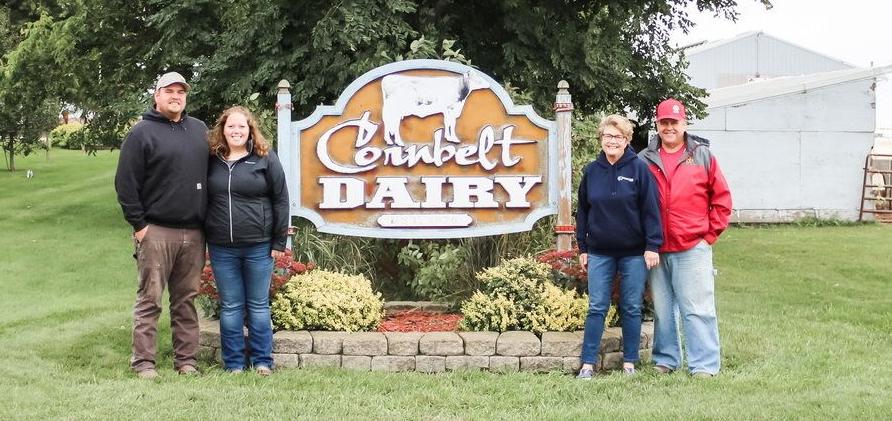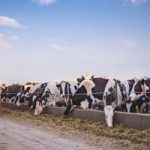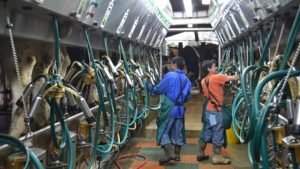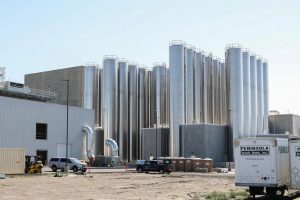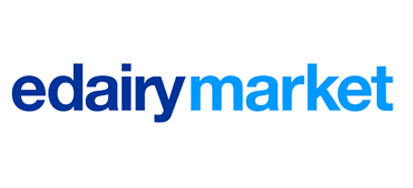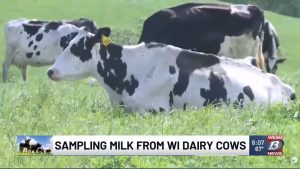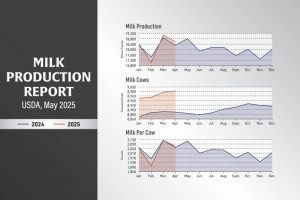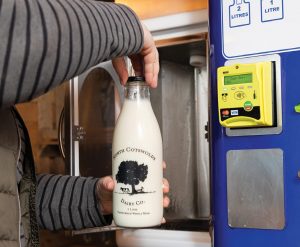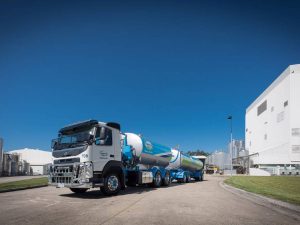
MARCUS—Joe Wilcox is dedicated to dairy.
Wilcox, who co-owns and operates the Cornbelt Dairy near Marcus, will join with other dairy owners to celebrate National Dairy Month in June. It was started in 1937 as National Milk Month as an effort to promote drinking milk during a nationwide surplus, according to the American Dairy Association. It was observed June 10-July 10 with the theme “Keep Youthful — Drink Milk.”
The National Dairy Council took over in 1939 and converted it to June Dairy Month, fixing it in the sixth month of the year. The dairy industry holds events, releases information and promotes the consumption of milk, cheese, ice cream and other dairy products.
“I just think it’s important to highlight a great, nutritious, fresh product,” said Wilcox, whose family owns a dairy southeast of Marcus. “There are too many positives not to promote and share it.”
Wilcox is the vice president of the Western Iowa Dairy Alliance, which was formed in 2007 to support dairy producers and the dairy industry in western Iowa.
Wilcox said dairy farmers have learned more over the decades and are producing more milk per cow. They are providing milk and dairy products for millions of people across the globe while dealing with the economic pressures and environmental demands that accompany the work.
They face higher costs for trucking, milk processing and labor. Just finding workers is a struggle for many dairies, Wilcox said, which is why new and stricter immigration policies are often discussed.
“The labor shortage is a real concern; these larger farms that rely on immigrant labor,” he said. “There’s a real concern with these guys as far as labor shortage.”
The need for people to milk, feed and care for cattle has grown as dairies have changed, Wilcox said.
“In 1970, there were 648,000 dairies. Now there’s 24,000 dairies,” he said. “That’s a huge drop in the amount of dairy farms, and 60 percent of the milk is from farms milking over 2,500 cows.”
That’s just 2.5 percent of farms. Many if not most of these large operations employ workers from Mexico, Central America and South America. A lot of those workers are in the country illegally.
Immigration worries
As President Donald Trump cracks down on undocumented workers, some bigger operators are watching and wondering if their farm will be raided and their employees taken away.
“It’s a real concern for some of them,” Wilcox said, noting this is a “very red corner of the state” that strongly supported Trump in the last three elections. “They’re voting for Trump but don’t want . . . the immigration policies make them a little nervous.”
One answer is automation.
The Cornbelt Dairy has been in the Wilcox family since 1876 and will celebrate 150 years in the industry in 2026.
Wilcox, his wife, Jill, and his parents, Mark and Sara, do almost all the work on the farm. Earlier this year, they were awarded $100,000 through the Choose Iowa Dairy Innovation Grants program to help in the purchase of two Lely robotic milkers, which will cost $422,628.68.
Wilcox said it’s “harder to scale robotics” on large dairies that milk thousands or cows daily. Some work round-the-clock.
They also need to feed and tend to the cattle. And workers are needed in hog barns as well, he said.
“Used to be, everybody would chore their own hog farm,” Wilcox said. “Big companies hire out.”
Milk prices are pretty good, but they fluctuate. Concerns about tariffs, including with Canada, Mexico and China, our biggest agricultural trading partners, add to dairy farmers’ worries.
Mexico imported $2.47 billion in dairy products from the United States in 2024, and Canada imported $1.14 billion. Both are record totals. China imports between $500 million and $800 million worth of U.S. dairy annually.
The International Dairy Foods Association urged the Trump administration to resolve ongoing tariff concerns with Canada Mexico, and China.
“A prolonged tariff war will deliver significant economic damage to American dairy farmers, processors, and the rural communities, and therefore we urge the administration to resolve these tariffs as soon as possible,” the International Dairy Foods Association stated earlier this year. “While we recognize that China and Canada have yet to fulfill the promises made in the Phase One and U.S.-Mexico-Canada Agreements, respectively, prolonged tariffs will further diminish market access. We strongly urge the administration to both resolve U.S. dairy’s trade barriers with these markets and the newly announced tariffs.”
It’s especially important to continue good relationships with other nations as the dairy industry, which supports more than 3.2 million jobs in the United States and pumps almost $800 billion into the U.S. economy.
Dairy farmers and related businesses are betting big on the future, according to the IDFA. They have invested more than $8 billion in new processing capacity that will soon be in operation.
“The industry exports roughly 18 percent of the milk it produces, and it relies on increased trade access to open new markets and increase exports. After being a net importer of dairy products a decade ago, the United States now exports $8 billion worth of dairy products to 145 countries. U.S. dairy exports topped $8.2 billion in 2024, the industry’s second-highest level ever.”
Wilcox said it’s a complex issue, and he would like to see new markets opened up as well as maintaining good relationships with current partners. He said issues such as this, as well as rising costs and up-and-down milk prices, come with the cows.
“It’s tough to predict how this is all going to shake up. There’s always a stresser you worry about,” Wilcox said. “But they’ve been worse, and they’ve been better. The cost of everything’s gone up.”
Dairies must adapt
Wilcox said dairy farmers will adapt. They are better at caring for and getting as much milk out of their herds than ever. They are more efficient as well to succeed in times of tighter margins. Some are finding ways to capture premium prices by selling organic milk and milk byproducts.
Breeding dairy cattle with beef bulls to produce and market more animals for meat is also rising in popularity.
The I-29 Moo University, a program sponsored by Extension and dairy industry staffers from Iowa, South Dakota, North Dakota, Minnesota and Nebraska to grow the dairy industry via outreach education, is sponsoring a webinar on beef-on-dairy industry.
The first one was held on May 21.
“With the growing dairy numbers along the I-29 corridor, beef-on-dairy feeders are an important part of most dairy’s financial statements,” said Fred Hall, an Iowa State University Extension and Outreach dairy specialist based in Orange City. “As the beef cow herd has shrunk, those calves are filling feedlots across the country.”
Wilcox, 36, is ready to learn and adapt to keep his family’s business thriving.
They milk 80 Holstein cattle on the last dairy farm in Cherokee County. He is part of the next generation of dairy farmers who are gradually replacing the men and women who have milked for decades.
Wilcox said that’s why he joined the Western Iowa Dairy Alliance, to make some contacts, network with other producers and learn more.
“And just kind of talk to people,” he said. “Going to be a huge shift as the baton gets passed to this next generation.”
It’s a demanding job, but one he loves.
“It’s exciting, and it’s nerve-racking at the same time,” Wilcox said. “It’s a huge financial commitment. I really enjoy working with the cows, I’m good with it.”
You can now read the most important #news on #eDairyNews #Whatsapp channels!!!
🇺🇸 eDairy News INGLÊS: https://whatsapp.com/channel/0029VaKsjzGDTkJyIN6hcP1K
